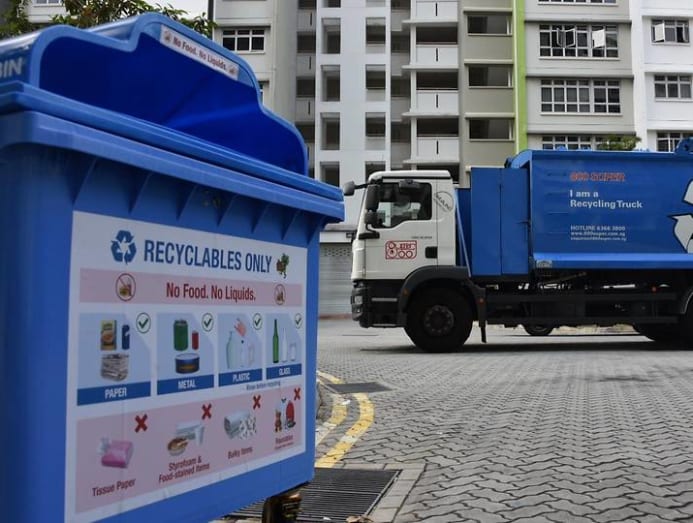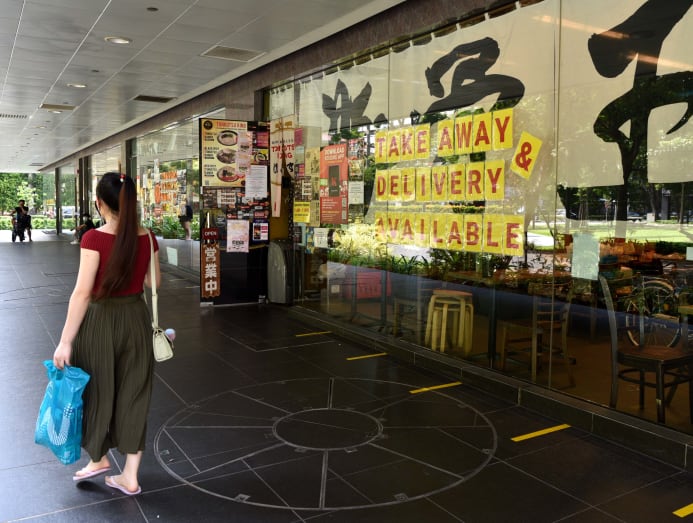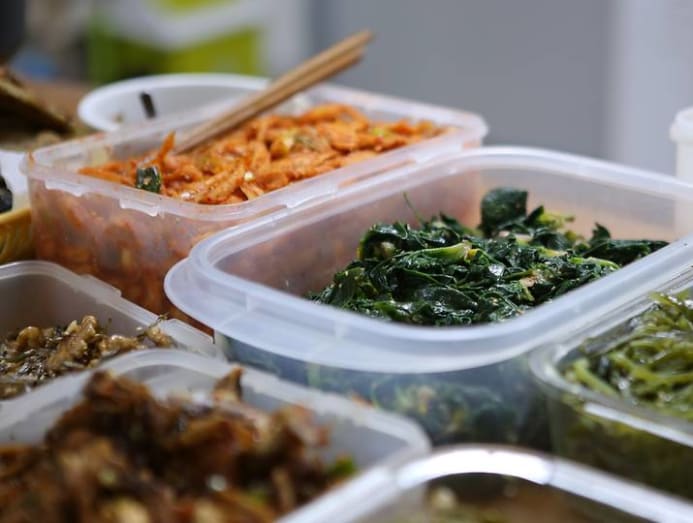Commentary: Here’s what months of food deliveries and takeaways have taught us
SINGAPORE: The COVID-19 pandemic has taken a toll on Singapore's food and potable industry.
Almost eateries breathed a sigh of relief with the announcement earlier this week that dining-in can resume in Phase ii on Jun 19, if rules are followed.
Takeaway meals and deliveries from familiar haunts take been indispensable these two months in bringing a semblance of normalcy to our lives.
Only as youths concerned about sustainability, one affair has become increasingly discomforting: Takeaway boxes, carriers and cutlery are often used in one case then thrown abroad. We've seen outset-hand how a single takeaway meal for the family results in an astounding amount of waste.
Mind: Entering Phase 2: What's behind rules on gatherings, dining, weddings and more?
LISTEN: Repairing and recycling to reduce e-waste: A pipe dream in Singapore?
A recent written report past NUS alumni establish that Singapore households generated an extra 1,334 tonnes of plastic waste – the weight of virtually ninety jitney buses – from takeaway and nutrient deliveries during the ii-calendar month excursion breaker.
Overall household waste matter had also soared with the restrictions on dining out. The National Environment Agency reported that 73,000 tonnes of waste was generated in April, upwardly 11 per cent from the previous month.
While some businesses have switched to more "eco-friendly" packaging like "biodegradable" containers, such packaging may non move the environs needle. In fact, many of these options accept more resources to produce, with their benefits unrealised since waste is incinerated in Singapore.
COVID-xix REVERSES MOVES TOWARDS Zilch Waste material
Prior to the pandemic, Singapore was making slow but steady progress towards zero-waste.
In 2017, non-governmental system Zero Waste product SG started the Bring Your Own (BYO) Singapore movement to nudge businesses and consumers towards reusable containers, cups and numberless.

The Ministry of the Surroundings and H2o Resources declared 2022 to be the Year Towards Zero Waste, which saw FairPrice extending its plastic purse charge trial after a successful month-long pilot, and concatenation bakeries like BreadTalk and Knuckles Bakery rolling out new schemes to reduce plastic bags.
Unfortunately, COVID-19 seems to have undone many of these efforts. Businesses and consumers accept go more than cautious about hygiene, wary of the risk that reusables could exist contaminated with the virus.
Some customers have expressed discomfort at the sight of personal containers placed abreast dispensable ones. Stores that used to back up BYO like Koi placed a temporary ban on reusable cups.
But experts say well-done reusables are safe when the coronavirus can be killed with regular dish soap and sanitisation
READ: No bear witness COVID-19 can be transmitted through nutrient or packaging: SFA
READ: Commentary: The apprehensive bar of lather is a powerful weapon against COVID-19
HOPE Notwithstanding FOR BYO
However, the surge in packaging consumption has also spurred positive change.
Earlier in April, Merchandise and Industry Government minister Chan Chun Sing urged people to BYO for their takeaways to "be more environmentally sustainable".
The pandemic has also highlighted applied reasons for businesses to reduce single-utilise packaging. Hawkers and F&B operators are grappling with higher packaging costs, given that suppliers have been overwhelmed by a surge in need for food containers.

READ: Commentary: The enormous growth of plastic packaging as have-outs and food deliveries surge must stop
Even our previously unconcerned family and friends have taken action. Our fathers take never taken to BYO and would even dismiss our calls to practise then in the past.
Simply our families' sheer number of takeaways during the circuit breaker have made them see how much waste is generated, and how beneficial BYO can exist, from ensuring food rubber to supporting local businesses. BYO has now become second nature to them.
F&B OUTLETS' ZERO-WASTE STRATEGIES
These habits may well outlive COVID-19, as the momentum to cut waste grows.
While consumers are doing more than to BYO, F&B outlets are as well making efforts to cutting packaging.
Shops like The Veggie Dojo offer reusable containers for food to be delivered in. Upon arrival, customers but transfer the food onto their own plates and return the containers immediately.
Establishments like Bollywood Veggies permit their customers return them on the next delivery.
READ: Commentary: We are becoming a 'dabao nation' – why does it experience like a bad matter?
LISTEN: How many stars will you requite Singapore's F&B industry this COVID-19 season?
Container-sharing services like Muuse and barePack assistance restaurants and diners in reducing plastic waste.
Operating on a subscription model, these services charge diners for unlimited use of their reusable containers and cups. barePack, for case, charges users S$5 per month or S$36 per yr – but during the circuit breaker made their service complimentary.
Diners rent the reusables to take away food at participating outlets, and return them after eating. Diners can also asking the food exist delivered in reusables from restaurants that offer them.
The container-sharing services lend reusables at no cost to restaurants, saving them the hassle and price of investing in their ain inventory of reusables.

These services accept been running before COVID-19, and take gained traction over the circuit breaker. Muuse currently has over xl F&B outlets under its chugalug, while barePack has over lx.
Most of the participating outlets are restaurants and cafes in the urban center, simply since the excursion breaker kicked in, both companies have expanded into eateries in residential areas and take launched commitment services, partnering with names similar Salad Stop and the Coffee Club to come up up with daily menus.
PUSHING FOR WIDESPREAD ADOPTION
Unfortunately, F&B outlets defended to waste reduction remain a minority. Many are still deterred by the perceived hassle and cost, and run into lilliputian do good to cutting packaging. Subsequently all, why change when the condition quo works fine?
Notwithstanding, taking steps to reduce single-employ plastic tin fatten bottom lines past reducing packaging costs in the long run. Moreover, they can appeal to a new wave of eco-conscious customers by expounding socially responsible values.
Operating more sustainably need not exist daunting. Eateries can beginning small-scale and calibration up along the fashion.
READ: Commentary: Why some plastic packaging is necessary
For starters, eateries could stop giving cutlery and napkins by default.
They could also get artistic in reducing excess packaging. For instance, multiple portions of rice can be put in 1 big container instead of being individually packaged.
This period is an opportunity for F&B outlets to experiment, test receptiveness and build habits amidst customers and staff.
READ: COVID-19: Delivery and takeaway models unsustainable, say eating house owners
THE ROLE OF CUSTOMERS
Customers also have a huge stake in turning the plastic tide.
With social distancing measures set to continue for months, customers who buy takeaways should BYO whenever possible.

The process is straightforward: Bring a clean and dry container large enough for your buy. Hand information technology over to the staff when ordering and asking for your food to exist put directly into it. Say that your aim is to reduce waste, so that staff will avert packing disposables altogether.
Of course, your attempts may occasionally be rejected by companies citing hygiene concerns. In this case, take it in your footstep and practice non exist demoralised.
Beyond changing our own habits, nosotros could encourage our favourite restaurants to adopt more than sustainable measures. Every bit non-turn a profit zilch-waste product chef Anne-Marie Bonneau says: "We don't need a handful of people doing nix waste perfectly. Nosotros need millions of people doing it imperfectly."
READ: Commentary: Wasteful practices of affluence must stop
READ: Commentary: Recycle or reduce waste product? Why Southeast Asia's body of water plastic pile has no easy answers
INDIVIDUAL ACTION IS NOT ENOUGH
For some, seeing plastic boxes and bowls stacked up in their cupboards have made them rethink their consumption patterns and brainstorm cultivating eco-conscious habits.
Yet individual effort will not suffice in the fight against the growing mount of waste matter, especially if food deliveries become the default post-pandemic.
Mr Chan's call to activeness was a motility in the right direction. If we were serious, nosotros would consider more aggressive policies to shift the needle: Levelling taxes on packaging waste product, financial and infrastructural support for null-waste systems and whole-of-government adoption of zero-waste matter measures.
The ascension of nutrient takeaways and deliveries presents us an opportunity to accelerate our nation'southward zero-waste matter journeying – merely they will count simply if we seize them.
Coco Oan is an Environmental Studies student at Yale-NUS College. Ang Li Shan is a Business organization student at the National Academy of Singapore. They are both members of Projection bECOme, a youth-run organisation that works to promote environmental sustainability among businesses and consumers.
Source: https://cnalifestyle.channelnewsasia.com/commentary/commentary-heres-what-months-food-deliveries-and-takeaways-have-taught-us-281221
Post a Comment for "Commentary: Here’s what months of food deliveries and takeaways have taught us"